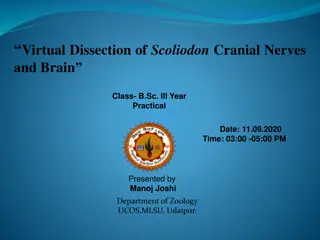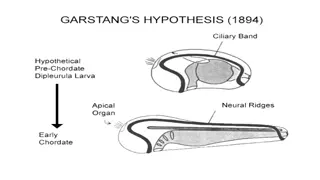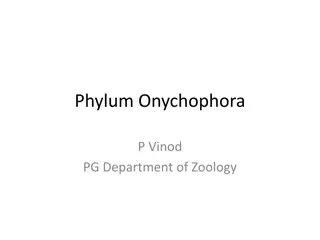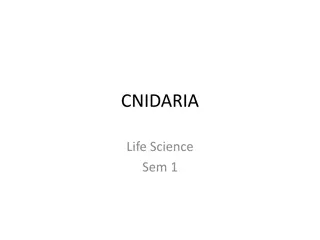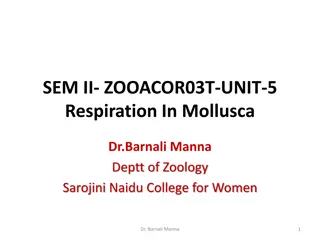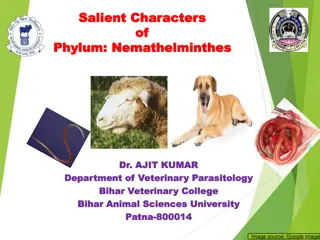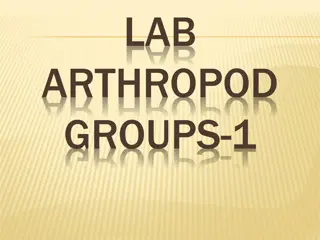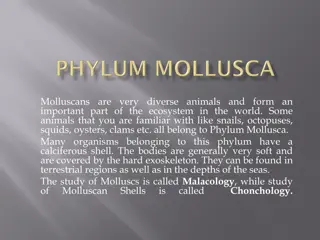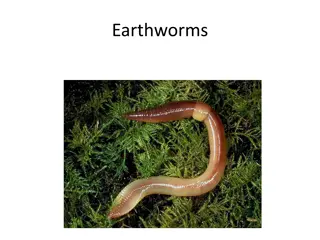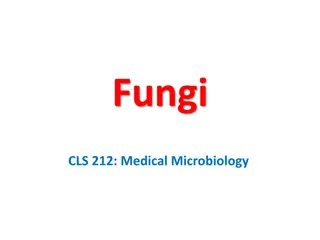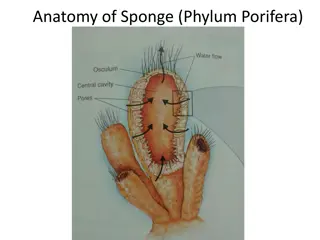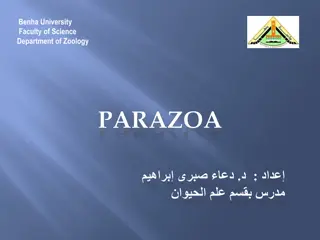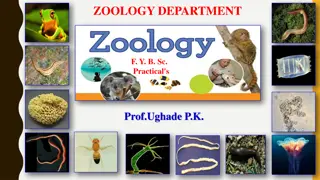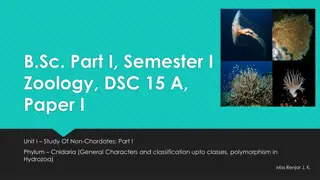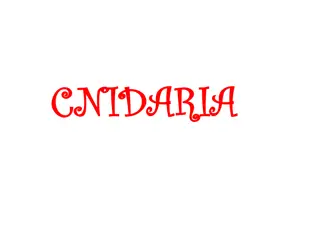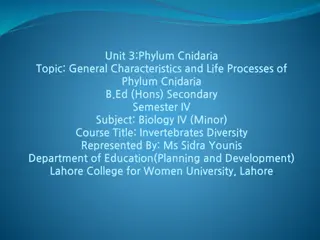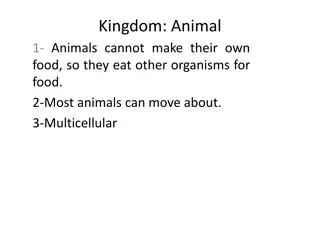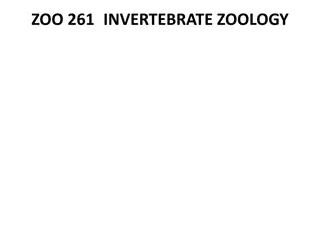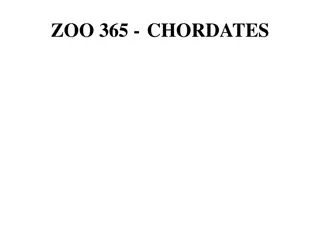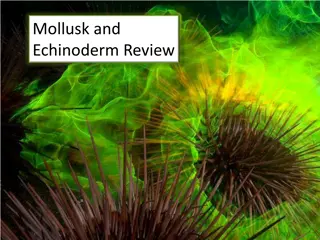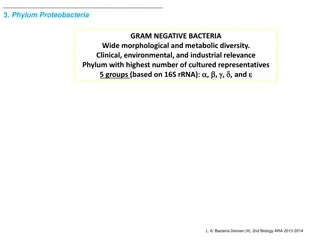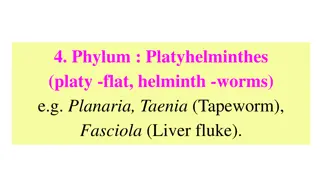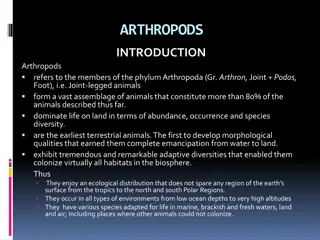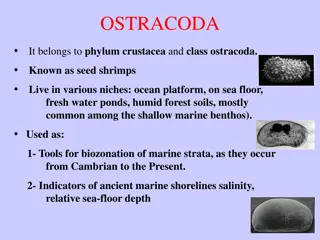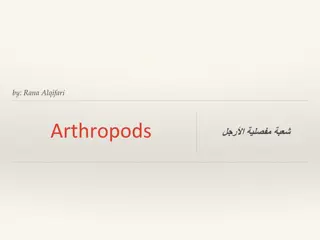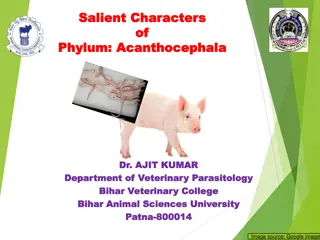Virtual Dissection of Scoliodon Cranial Nerves and Brain: A Detailed Practical Guide
Explore the virtual dissection of Scoliodon's cranial nerves and brain in this informative practical session for B.Sc. III Year students. Learn about the anatomy and innervations of various nerves like Olfactory, Optic, Trigeminal, Facial, and more. Discover the phylum, group, and class of Scoliodon
0 views • 9 slides
Overview of Agnatha: Jawless Fish in Chordata
Agnatha, the superclass of jawless fish in the phylum Chordata, includes both present (cyclostomes) and extinct species. Cyclostomes, such as lampreys and hagfishes, lack jaws and have unique adaptations. They have primitive characteristics like a circular mouth and lack of paired fins, alongside sp
1 views • 15 slides
Phylogenetic Status of Peripatus: Exploring its Systematic Position
Peripatus, known as claw bearers, exhibits characteristics of both annelids and arthropods, making it an intriguing species in the study of evolutionary biology. Considered as an intermediate link between these two phyla, Peripatus raises questions about its classification and evolutionary history.
0 views • 10 slides
Understanding the Unique Features of Phylum Cnidaria in Life Science
Phylum Cnidaria comprises diverse marine animals like jellyfish, sea anemones, corals, and Hydra, exhibiting radially symmetric bodies with unique structures called cnidocytes. These cnidocytes serve as sensory-effector cells that contain specialized stinging organelles called cnidae, aiding in defe
0 views • 7 slides
Respiration in Mollusca: Adaptations to Different Habitats
Mollusca exhibit various modes of respiration depending on their habitat - aquatic, terrestrial, or amphibious. Different respiratory organs are modified accordingly, such as ctenidia or gills for aquatic species, pulmonary sac for aerial species, and mantle or integument for those lacking specific
0 views • 17 slides
Overview of Nemathelminthes: Salient Characters and General Characteristics
Nemathelminthes, a phylum of eukaryotic organisms, include parasites such as helminths. This summary covers the salient characters and general characteristics of Nemathelminthes, focusing on the classes within this phylum, like Nematoda. The description highlights key features like body shape, prese
0 views • 15 slides
Overview of Arthropods: Classification and Characteristics
Arthropods are a diverse group of invertebrates characterized by segmented bodies, appendages, and chitinous exoskeletons. They belong to the Phylum Arthropoda and are classified into four important classes: Myriapoda, Crustacea, Arachnida, and Insecta. This article explores the unique features of e
0 views • 18 slides
Insights into Evolutionary Adaptation and Genetic Variation
The production order highlights the essential role of genomic variation as fuel for natural selection, driving evolutionary adaptation. The Cambrian Explosion timeframe reveals a rapid increase in evolutionary adaptation, showcasing the appearance of diverse animal phyla over a relatively short peri
5 views • 6 slides
The Diverse World of Molluscs: An Overview
Molluscs are diverse animals found in both terrestrial and aquatic habitats. They belong to Phylum Mollusca and exhibit characteristics such as a calciferous shell, bilateral symmetry, and a well-developed body system. The study of Molluscs is called Malacology, while the study of Molluscan Shells i
3 views • 11 slides
Fascinating Facts About Earthworms and Their Importance in Gardens
Discover the crucial role earthworms play in gardening, from breaking down organic matter to aerating the soil and promoting nutrient uptake by plants. Learn about the phylum they belong to and explore informative videos on earthworm behavior and reproduction. Don't miss the intriguing video on the
0 views • 7 slides
Understanding Chytridiomycota: The Flagellated Fungi
Chytridiomycota is a phylum of fungi distinguished by having motile spores with a single posterior flagellum. They are primarily aquatic, parasitic on algae and animals, and play a role in plant diseases. Their unique characteristics include alternation of generation and somatic phase with rhizoids.
8 views • 11 slides
Understanding the Fascinating World of Fungi: Mycology Insights
Explore the realm of fungi through the lens of mycology, delving into their diverse characteristics, including their eukaryotic nature, heterotrophic lifestyle, and impact on various ecosystems. Discover how fungi play crucial roles as saprophytic, symbiotic, or parasitic organisms, influencing food
0 views • 26 slides
Comparative Anatomy of Sponge and Cnideria Phylum
Explore the intricate anatomical structures of sponges (Phylum Porifera) and Cnideria, including polyps and medusas. The visuals provide an in-depth look at the unique characteristics and functions of these fascinating marine organisms.
0 views • 4 slides
Introduction to Porifera: The Simple Multicellular Animals Known as Sponges
Porifera, a phylum of simple multicellular animals known as sponges, lack proper tissues and organs. They are filter feeders found in aquatic environments, with varied shapes and structures. Nutrition, digestion, respiration, excretion, and reproduction in sponges occur uniquely, making them intrigu
0 views • 18 slides
Classification and Characteristics of Phylum Protozoa
Phylum Protozoa comprises unicellular, microscopic, eukaryotic organisms found mostly in aquatic habitats. They exhibit diverse locomotory structures such as cilia, flagella, or pseudopodia. These protists may possess a cellulose cell wall and various membrane-bound organelles like mitochondria and
0 views • 21 slides
Understanding Taxonomy and Classification in Biology
Scientists use classification to group organisms logically, making it easier to study life's diversity. Taxonomy assigns universally accepted names to organisms using binomial nomenclature. Carolus Linnaeus developed this system, organizing organisms into species, genus, family, order, class, phylum
0 views • 11 slides
Study of Phylum Cnidaria: General Characters and Classification
Phylum Cnidaria comprises aquatic organisms with specialized stinging cells known as cnidoblasts. They exhibit radial symmetry and are triploblastic, with distinct polyp and medusa forms. The phylum includes classes like Hydrozoa, Scyphozoa, and Anthozoa, each displaying unique characteristics and m
0 views • 6 slides
Overview of Phylum Cnidaria: Classification and Characteristics
Phylum Cnidaria consists of around 10,000 species classified into 5 classes: Hydrozoa, Anthozoa, Cubozoa, Scyphozoa, and Staurozoa. Each class has unique characteristics and examples, such as the sea serpents in Hydrozoa and flower animals in Anthozoa. Cnidarians exhibit radial or biradial symmetry,
0 views • 16 slides
Exploring the Characteristics of Phylum Cnidaria
Phylum Cnidaria, derived from the Greek word meaning stinging nettle, encompasses various marine species like jellyfish, sea anemones, and corals. These animals exhibit traits such as being diploblastic, with an ectoderm and endoderm separated by mesogloea. They possess a gastrovascular cavity, nema
0 views • 27 slides
Overview of Animal Kingdom's Phyla and Characteristics
Animals in the Kingdom Animalia have diverse characteristics and are classified into different phyla based on specific traits and features. This includes Porifera (sponges), Cnidaria (jellyfishes), Platyhelminthes (flatworms), Nematoda (roundworms), Annelida (earthworms), Mollusca (snails, octopus),
0 views • 10 slides
Exploring the World of Invertebrate Zoology: Phylum Nematoda and Its Classes
In this detailed study of invertebrate zoology, we delve into the Phylum Nematoda, commonly known as roundworms. Highlighting their anatomy and classification, we examine the Ascarididae class, featuring Ascaris, and the Strongylidae class, represented by Ancylostoma. These simple yet diverse organi
0 views • 171 slides
Medically Important Hemoflagellates: Trypanosoma and Leishmania
Hemoflagellates belong to the phylum Sarcomastigophora and include medically significant genera such as Trypanosoma and Leishmania. These parasites are transmitted by insects and exhibit complex life cycles. Trypanosoma species, such as T. cruzi and T. brucei, cause diseases like Chagas' disease and
0 views • 18 slides
Exploring the Diversity of Chordates in the Animal Kingdom
Delve into the world of chordates through vivid images and detailed descriptions, uncovering the classification of these fascinating creatures into subphyla and the distinctive features that define them. From acorn worms to mammals, each subgroup offers a unique glimpse into the rich tapestry of ver
0 views • 168 slides
Exploring Mollusks and Echinoderms
Delve into the fascinating world of Mollusks and Echinoderms through this informative review. Learn about their unique characteristics such as radula, tube feet, gills, and bilateral symmetry. Discover the importance of these features in the diverse phyla of Mollusca and Echinodermata, including the
0 views • 25 slides
Overview of Mollusca Classification and Characteristics
The phylum Mollusca includes organisms with diverse characteristics such as marine and freshwater habitats, a range of body structures, and unique reproductive strategies. This overview discusses the classification of Mollusca, covering groups like Aplacophora, Gastropoda, Bivalvia, and Cephalopoda,
0 views • 10 slides
Exploring the Diverse World of Proteobacteria
Proteobacteria, a phylum of Gram-negative bacteria, exhibit wide morphological and metabolic diversity with clinical, environmental, and industrial relevance. This phylum, boasting the highest number of cultured representatives, is divided into various groups based on 16S rRNA sequencing. From N2-fi
0 views • 49 slides
Understanding Cestoda: The Tapeworms in Platyhelminthes
Cestoda, a class of parasitic flatworms in the phylum Platyhelminthes, have a unique body structure with a scolex, neck, and segmented strobila. These tapeworms lack a digestive tract, absorbing nutrients through their body. They are hermaphrodites, with male and female reproductive organs in the sa
0 views • 12 slides
Fascinating World of Earthworms: An In-Depth Look
Earthworms, belonging to the phylum Annelida, are nocturnal creatures found in moist soil. They play a crucial role in soil health and decomposition processes. With their unique morphology and habitat preferences, earthworms exhibit interesting behaviors like burrowing and regenerating. This article
0 views • 19 slides
Understanding Platyhelminthes: Characteristics and Adaptations
Platyhelminthes, also known as flatworms, exhibit a dorsoventrally flattened body with bilateral symmetry. They can be endoparasites or free-living organisms, with some displaying unique adaptations for attachment and survival. These acoelomate organisms lack a complete digestive system, excreting w
0 views • 6 slides
Exploring Crayfish Anatomy and Adaptations in Biology Lab
Explore the fascinating world of crayfish anatomy and adaptations through hands-on dissection activities in a biology lab setting. Identify phylum, examine external anatomy, study compound eyes, and delve into the function-form relationship within the phylum. Engage in interactive tasks like drawing
0 views • 22 slides
Fascinating World of Arthropods: Incredible Adaptations and Ecological Dominance
Arthropods, joint-legged animals of the phylum Arthropoda, comprise over 80% of described animal species and exhibit remarkable adaptive diversities. They dominate various habitats, colonizing land, air, and water. Arthropods play significant ecological roles, with diverse feeding habits and efficie
0 views • 32 slides
Overview of Ostracoda: Seed Shrimps of the Crustacean World
Ostracoda, belonging to phylum Crustacea, are known as seed shrimps and inhabit diverse environments from ocean platforms to freshwater ponds. They serve as valuable tools for biozonation and indicators of ancient marine conditions. Their carapace, composed of chitinous or calcareous material, showc
0 views • 11 slides
Fascinating World of Arthropods: Diversity and Characteristics
Arthropods, the largest phylum in the animal kingdom, exhibit a wide array of characteristics and play crucial roles in various ecosystems. From crustaceans to insects, these invertebrates showcase segmented bodies, jointed appendages, and diverse respiratory systems. Explore the world of arthropods
0 views • 12 slides
Salient Characters and General Features of Phylum Acanthocephala
Discover the salient characters and general features of Phylum Acanthocephala, a group of parasitic organisms with unique anatomical characteristics. Explore the body structure, presence of a retractable proboscis, absence of body segmentation and alimentary canal, as well as the lack of certain org
0 views • 10 slides
